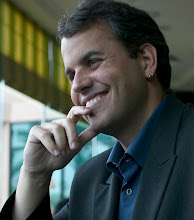This week was my fourth faculty seminar. Dmitri Williams tag teamed with me and I'll get the slides up with commentary early next week.
Class was exceptionally interesting this week because Janice Rohn of Yellowpages.com was our guest speaker. Now, I have to be honest. I had never been to Yellowpages.com and approached the class with a pretty negative opinion of the Yellow Pages because I haven't used one in a decade yet they keep tossing these huge, useless books on my front door.
Janice changed my opinion. Completely.
Janice is a usability expert who has worked at Stanford, Apple, Sun, World Savings Bank, and Yellowpages.com. She has a spectacularly clear view of the process of usability and ability to convey its importance. She is also a great spokesman for Yellowpages.com. Did you know they were the number one local search site and are owned by AT&T? Me neither. Their site has a very polished iPhone interface that works very well. Who knew?
More generally, she spent about 90 minutes laying out her approach to usability design and answering questions. I can't hope to do it justice -- try to hear her give it sometime -- but among the many interesting points:
- User experience, like all interesting fields, traces its methodological roots back to IBM and Xerox. It has only become a basic part of most businesses since the Web emerged.
- User experience is a mix of the usefulness, learnability, memorability, and efficiency of the activities a user takes part in, all trumped by the satisfaction they feel upon completing a task. For example, the satisfaction at the end of a search task is more important than the time it takes to find information. (I find that balance of particular interest in regards to Second Life)
- She recommended Danny Meyer's "Setting the Table" as a great discussion of user experience. Interesting that I'm not the only one using restaurants as an example.
- In the balance between product presentation and structure, user are more aware of the presentation, but in the long run usability is actually driven by the structure. Again, very salient to virtual world discussions.
- Companies never publish their data, but user experience has the highest impact on retention, sales, and support costs of any product factor.
- In product development, lack of user involvement is the number one driver of missed deadlines and canceled projects. What does this say about game development, generally viewed as the latest and riskiest software projects?
- During user testing, it is critical to remember that people think in terms of solutions, but you are trying to tease out requirements instead.
- For every 100 people who have a bad user experience, 50 will tell 8 to 16 others. Bad experiences are incredibly viral!
- When trying to assess user experience on small projects, decide on target market -- so niche is easier! -- and create user profiles. Find out what is important to those profiles, understand their top requirements and stick to them. Don't try to solve everything! Use your competition to held define the profiles and understand what makes your project unique.
The rest of class was taken up by presentations on our second module, which included viral marketing, legal issues, and investing which I will get to in my next post.

No comments:
Post a Comment